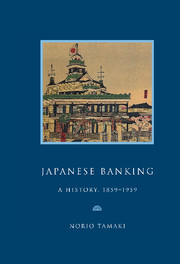Book contents
- Frontmatter
- Contents
- Preface
- Genealogy of leading Japanese banks, 1859–1959
- List of abbreviations
- Map
- Part I A bankrupt Shogunate, 1859–1868
- Part II The Meiji Restoration: monetary confusion and banking experiments, 1868–1881
- Part III Matsukata, the wizard of Japanese banking, 1881–1897; the Yokohama Specie Bank (1880) and the Bank of Japan (1882)
- Part IV The Japanese on the London money market, 1897–1911
- Part V War, the Japanese boom years, 1911–1919
- Part VI Crisis and the road to war, 1919–1937
- Part VII Complete commitment, struggle and defeat, 1937–1945
- Historical background
- 25 War budgets and the mobilisation of national resources, 1937–1943
- 26 Extraordinary banking business during the national emergency, 1941–1945
- 27 Crisis, 1945
- Part VIII American ‘democratisation’ and the search for growth, 1945–1959
- An extraordinary century, 1859–1959
- Appendices
- Notes
- Bibliography
- Index
Historical background
Published online by Cambridge University Press: 03 February 2010
- Frontmatter
- Contents
- Preface
- Genealogy of leading Japanese banks, 1859–1959
- List of abbreviations
- Map
- Part I A bankrupt Shogunate, 1859–1868
- Part II The Meiji Restoration: monetary confusion and banking experiments, 1868–1881
- Part III Matsukata, the wizard of Japanese banking, 1881–1897; the Yokohama Specie Bank (1880) and the Bank of Japan (1882)
- Part IV The Japanese on the London money market, 1897–1911
- Part V War, the Japanese boom years, 1911–1919
- Part VI Crisis and the road to war, 1919–1937
- Part VII Complete commitment, struggle and defeat, 1937–1945
- Historical background
- 25 War budgets and the mobilisation of national resources, 1937–1943
- 26 Extraordinary banking business during the national emergency, 1941–1945
- 27 Crisis, 1945
- Part VIII American ‘democratisation’ and the search for growth, 1945–1959
- An extraordinary century, 1859–1959
- Appendices
- Notes
- Bibliography
- Index
Summary
In June 1937, Prince Konoe was handed an imperial edict and ordered to form a cabinet. Exactly a month later, the Marco Polo Bridge Incident occurred, engineered by elements of the Japanese army, and it developed into the Sino-Japanese War. More than two years before the German invasion of Poland, Japan was effectively at war. In July 1940, the second Konoe cabinet prepared Japanese invasion plans for South East Asia, a direct response to the German success in Europe. Two months afterwards the Tripartite Pact between Japan, Germany and Italy was concluded. In June 1941 the Japanese army and navy invaded French Indo-China, an action which was fatal for the American–Japanese negotiations in which the second Konoe cabinet was desperately, if incompetently, engaged. It was, however, the Tojo cabinet in October 1941 which determined the surprise attack on Pearl Harbor on 8 December 1941 (Japan Time) initiating all-out war against the rest of the world in the Pacific area. Despite the spectacular advance of the Japanese forces south-eastwards into Asia, within six months, in June 1942, Japan lost the Battle of Midway. This was indeed, in military and in economic terms, the crucial turning point of the Pacific War. In spite of her achievement, Japan was never in a position to win this war. As early as 1942 Japanese industrial production was in the doldrums and her economic resources were, despite the National General Mobilisation policies, exhausted. Japanese banking, well integrated into the national economy, was in the same boat which ultimately sank in August 1945.
- Type
- Chapter
- Information
- Japanese BankingA History, 1859–1959, pp. 173Publisher: Cambridge University PressPrint publication year: 1995



